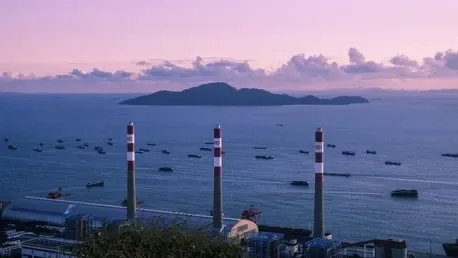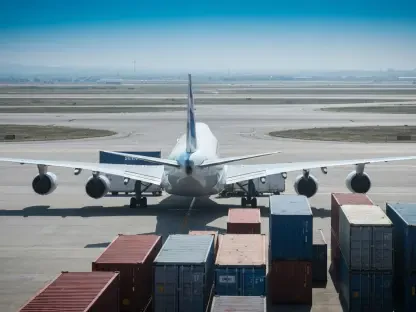On August 10, 2024, a significant explosion rattled the Port of Ningbo-Zhoushan in China, casting a spotlight on the critical issue of shipping safety. The incident involved the container ship YM Mobility, operated by Taiwan’s Yang Ming Marine Transport Corp. The explosion, which was felt up to a kilometer away, fortunately, resulted in no casualties among the 20 crew members, who evacuated safely. However, the damage was extensive and raised urgent questions about the safety protocols in the maritime industry, especially concerning the transportation of hazardous materials.
Immediate Aftermath and Initial Findings
Explosion Details and Immediate Response
The explosion occurred around 1:40 PM, shortly after the YM Mobility arrived from Shanghai. The blast originated from a container holding hazardous materials that were misclassified as not needing plugged-in electricity. Such misclassification proved to be critical as these hazardous materials included highly combustible goods such as lithium batteries. The initial shockwave hit the surrounding area with a force powerful enough to be felt up to a kilometer away, causing extensive damage to the terminal. However, quick action by Ningbo Zhoushan Port Co. Ltd. prevented a more catastrophic outcome. Their immediate fire control measures managed to contain the situation, effectively limiting what could have been a far more severe disaster.
The evacuation of the 20 crew members was executed swiftly, thanks in part to well-prepared emergency protocols. Yang Ming Marine noted that their fire response protocols worked efficiently, highlighting the importance of immediate action in such critical scenarios. The successful containment emphasizes the effectiveness of these protocols, although it also underscores the need for ongoing readiness. It was reported that the YM Mobility, with a carrying capacity of 6,600 twenty-foot equivalent units (TEUs), had been scheduled to continue its route to Jakarta, Indonesia. However, substantial repairs now await the ship, and according to China Central Television (CCTV), these could take up to three months to complete.
Investigative Insights
Preliminary investigations suggested that the explosion was likely due to overheating within the container’s cooling system. This incident has sparked a significant call for tighter regulations on the transportation and handling of dangerous goods. For instance, the improper classification of the container as not needing plugged-in electricity when it contained combustible materials indicates a systemic issue that requires immediate addressing. Initial findings underscore the crucial role of proper classification and temperature control measures in preventing such calamities. Safety experts are pointing to these elements as key factors that must be revised to avert future disasters.
In response to the explosion, Yang Ming Marine and its subsidiary Huan Ming started collaborating closely with local authorities to manage the aftermath. They assured stakeholders that continuous updates would be provided on the vessel’s operational status and adjustments to cargo schedules. Beyond managing the immediate crisis, this collaboration is a sign of the broader industry movement toward increasing scrutiny and operational safety. The heightened scrutiny on the transportation of hazardous materials is expected to usher in more stringent safety measures, aimed at eliminating or minimizing similar risks in the future. Regulatory bodies are already contemplating implementing stricter guidelines, which could include more rigorous checks and improved classification systems for dangerous goods.
Broader Implications for the Shipping Industry
Historical Context of Safety Incidents
The explosion on the YM Mobility is a stark reminder that incidents involving container ships and hazardous materials are not unprecedented. Historical context reveals that the maritime industry has had its share of safety challenges. Previous notable incidents, such as the fatal electrical fire on the Maersk Frankfurt and the collapse of the Baltimore Bridge caused by another container ship, underscore these recurring safety concerns. These incidents point to a broader pattern of vulnerabilities within the maritime industry. Each incident brings forth lessons that industry stakeholders must heed to prevent future occurrences.
The fatal electrical fire on the Maersk Frankfurt, for instance, serves as a grim reminder of the potential human cost of inadequate safety measures. The loss of a crew member during the vessel’s maiden voyage heightened awareness about the deficiencies in fire safety protocols and the handling of hazardous materials. Likewise, incidents like the Baltimore Bridge collapse draw attention to structural vulnerabilities and the dire consequences of technical failures or misclassifications. Collectively, these events paint a vivid picture of the persistent and widespread safety issues that plague the shipping industry. Addressing these challenges requires a comprehensive approach, combining robust regulatory frameworks, improved safety technologies, and exhaustive personnel training programs.
Expert Opinions and Industry Criticism
Peter Sand, a chief analyst at Xeneta, has been vocal about the failures of current safety protocols. He emphasized that had the explosion on the YM Mobility occurred while the vessel was at sea, the consequences could have been catastrophic. The risk to crew members and the ship’s integrity would have been significantly higher, amplifying the urgency for revising and reinforcing safety regulations. Sand’s critique has resonated widely within the industry, drawing attention to the glaring gaps in existing safety measures. His comments reflect a growing consensus among industry experts that the transportation of hazardous materials necessitates far more stringent safety protocols.
Such expert opinions carry weight in influencing industry standards and regulatory policies. The insights provided by experts like Sand highlight the critical importance of learning from past mistakes and implementing lessons to drive continuous improvement in safety protocols. The shipping industry must be proactive in adapting to evolving risks and emerging threats, rather than merely reacting to incidents after they occur. This proactive approach involves not only updating safety protocols but also fostering a culture of safety awareness and vigilance among all stakeholders. Incorporating expert insights into regulatory frameworks and industry practices can help mitigate risks and enhance the overall resilience of maritime operations.
Regulatory Response and Safety Measures
Calls for Stricter Regulations
In the wake of the explosion, the response from regulatory bodies has been swift and pointed. Increased scrutiny and calls for stronger safety measures have become the dominant narrative. Yang Ming Marine and its subsidiary Huan Ming have begun working closely with local authorities to manage the aftermath, ensuring that continuous updates on the vessel’s operational status and adjustments to cargo schedules are provided. This incident is likely to prompt a broader industry reassessment of the protocols for transporting hazardous materials. Industry analysts anticipate that regulatory bodies will impose more stringent standards, such as improved classification systems and more rigorous safety checks.
This push for stricter regulations is seen as not just a reactionary measure but a necessary step in precluding future calamities. Stricter guidelines would require shipping companies to adhere to enhanced safety standards, including proper labeling, better acknowledgment of the cargo’s nature, and ensuring that containers with hazardous materials are equipped with adequate cooling systems. Such measures are crucial for minimizing the risks associated with transporting dangerous goods. The regulatory landscape is expected to evolve rapidly, with increased oversight aiming to align industry practices with the heightened risks posed by the global transportation of hazardous materials.
Implementation of Safety Protocols
While the immediate containment of the explosion by Ningbo Zhoushan Port Co. Ltd. underscored the effectiveness of some existing fire response protocols, it also revealed areas that demand improvement. The industry must prioritize the enforcement of stringent guidelines and regular safety checks to prevent future incidents. The successful evacuation and containment procedures illustrate the critical role of preparedness and quick action in mitigating disaster impacts. However, the incident also highlights the need for ongoing readiness and more robust measures to handle such emergencies effectively.
Ongoing readiness involves not just routine checks and compliance with safety standards but also investing in advanced technologies to detect, monitor, and manage hazardous materials. The integration of such technologies can significantly enhance safety protocols, providing real-time data and early warning systems to avert potential dangers. Additionally, regular drills and comprehensive training for personnel involved in handling hazardous goods are essential. These measures collectively contribute to a more resilient and safer maritime environment. Ensuring that all stakeholders are well-versed in safety protocols and emergency response procedures can play a pivotal role in preventing accidents and maintaining high safety standards across the industry.
Impact on Global Trade and Shipping Market
Resilience of Maritime Systems
Despite the severity of the Ningbo-Zhoushan explosion, experts like Peter Sand do not anticipate major disruptions within the global shipping market. The resilience and importance of the port, coupled with the industry’s ability to adapt and evolve, suggest that any disturbances are likely to be temporary. Historical data supports this view, indicating that while such incidents can cause short-term disruptions, the maritime industry has consistently demonstrated its ability to recover and maintain continuity in operations. The resilience of maritime systems is a testament to the robustness of global supply chains and the critical role that ports like Ningbo-Zhoushan play in facilitating international trade.
The adaptability of the shipping industry in the face of crises highlights its underlying strength and capacity for innovation. Past incidents have spurred advancements in safety technologies, regulatory frameworks, and operational practices, all of which contribute to the sector’s ability to withstand shocks. Shipping companies and port authorities continuously refine their protocols to address emerging threats and vulnerabilities. This ongoing process of improvement ensures that the industry remains resilient, maintaining the flow of goods across the globe even in the aftermath of significant events like the Ningbo-Zhoushan explosion.
Economic and Operational Concerns
The explosion at Ningbo-Zhoushan underscores the delicate balance between operational efficiency and safety in shipping hazardous materials. The incident has brought to light the potential ripple effects on international supply chains, given the high volume of global trade through such ports. Maintaining robust safety standards is imperative to ensure economic stability while mitigating the risks associated with transporting dangerous goods. The maritime industry must navigate the complex interplay between efficiency, cost-effectiveness, and stringent safety measures to prevent similar occurrences in the future.
The economic implications of such incidents can extend beyond immediate disruptions, affecting shipping rates, insurance premiums, and operational costs. However, the industry’s resilience and adaptability have historically mitigated long-term economic impacts. Ensuring that safety protocols are aligned with best practices and regulatory standards can help maintain operational efficiency while safeguarding against potential hazards. The incident at Ningbo-Zhoushan serves as a critical reminder for stakeholders to prioritize safety without compromising on efficiency, reinforcing the need for a balanced approach in managing maritime operations.
Technological and Educational Advancements
Role of Emerging Technologies
Emerging technologies stand at the forefront of advancements in maritime safety, particularly in the detection, monitoring, and management of hazardous materials. Innovations such as real-time monitoring systems, temperature control mechanisms, and automated alert systems can significantly enhance safety protocols. Integrating such technologies into shipping practices can provide early warnings and real-time data to prevent mishaps like the YM Mobility explosion. Investing in these technological advancements is essential for the industry to evolve and meet the challenges posed by the transportation of dangerous goods.
The adoption of cutting-edge technologies not only improves safety but also increases operational efficiency, allowing for more accurate and timely responses to potential threats. For instance, advanced sensors and IoT devices can continuously monitor the condition of hazardous materials, ensuring that any deviations from safe parameters are promptly addressed. Moreover, artificial intelligence and machine learning algorithms can analyze data trends to predict and mitigate risks before they escalate. Such technological integration fosters a safer maritime environment, reducing the likelihood of incidents and enhancing the overall safety standards within the industry.
Importance of Training and Education
Comprehensive training and education programs are equally crucial in bolstering maritime safety standards. Shipping companies must invest in regular training exercises that simulate emergency scenarios, ensuring that crew members and port staff are well-prepared to handle hazardous materials and respond effectively to crises. The incident at Ningbo-Zhoushan underscores the need for ongoing education and skill development to maintain a high level of readiness and proficiency in managing dangerous goods.
Implementing thorough training programs helps instill a culture of safety awareness and vigilance among all stakeholders. By equipping personnel with the knowledge and skills necessary to navigate the complexities of hazardous material transportation, the industry can significantly reduce the risk of accidents. Continuous education initiatives also foster a proactive approach to safety, encouraging the adoption of best practices and adherence to regulatory standards. Investing in training and education is paramount to ensuring the long-term safety and sustainability of maritime operations.









